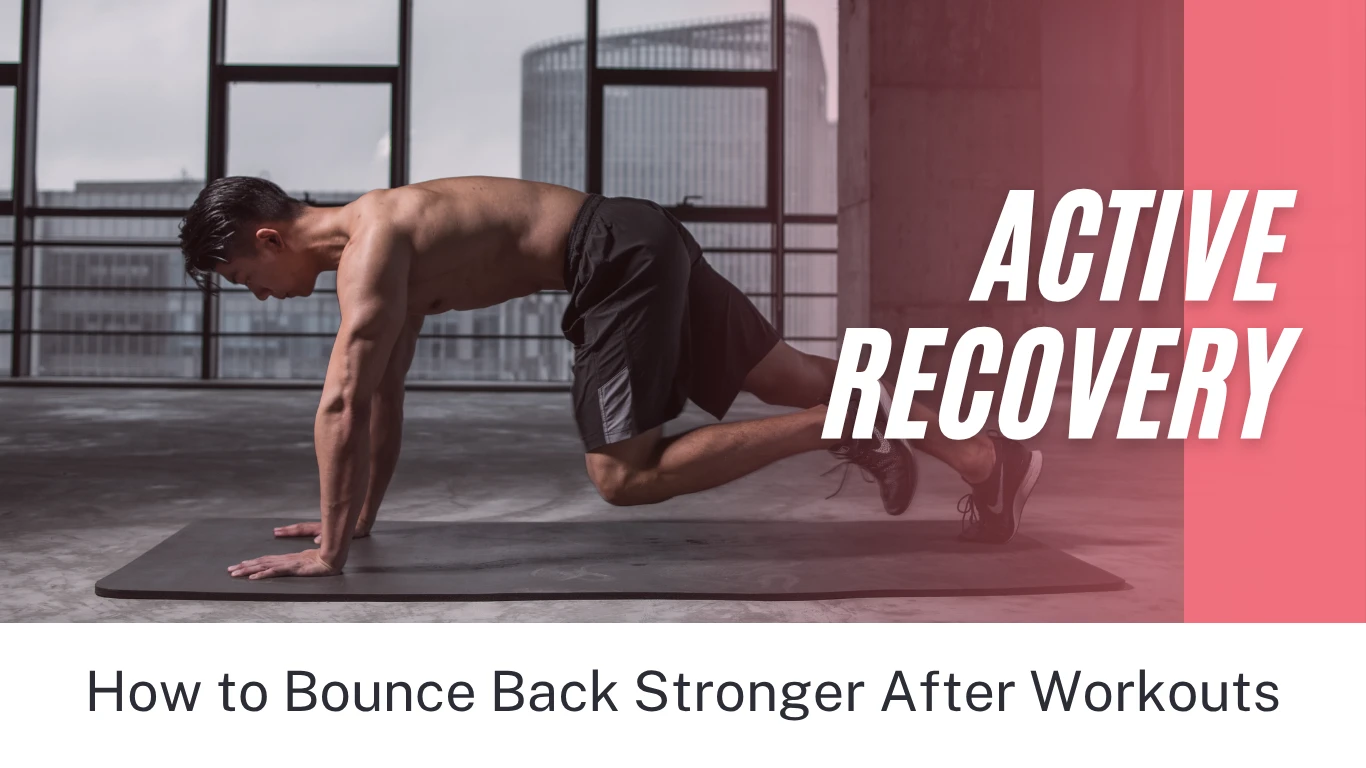Summary
Active recovery is a shift in paradigm from passive rest to intentional low-intensity movement that speeds up recovery techniques without losing fitness momentum. This comprehensive guide examines how enhanced blood flow and waste removal assist active recovery to exceed traditional rest days. We provide seven easy workouts, optimal scheduling tips, and nutritional recommendations intended to aid in recuperation. The study considers the critical role sleep plays, stretches, and what not to do if injured muscles develop. We cover rehabilitative fundamentals from foam rollers to compression clothing and give home exercises with no equipment required. These evidence-based methods can assist you in converting recuperation days into productive sessions enhancing performance, reducing the risk of injury, and maintaining consistency within your exercise routine. Not only an alternative to rest, but a wonderful training device that utilizes your entire athletic development most effectively is active recovery.
Introduction
During off-season, active recuperation has revolutionized the life of athletes and fitness enthusiasts. Contrary to outright inactivity, active recuperation is low-intensity training designed to increase blood flow and allow the muscles to heal and rebuild themselves. This strategic method gets the best of both worlds as it strikes a compromise between rigorous training sessions and total downtime. We will look at why active recovery supplants traditional days of rest, give easy-to-do exercises and routines, discuss nutrition plans, and cover recovery techniques that optimize results most efficiently in the guide that follows. Whether your weekend warrior athlete or competitive athlete, mastering how to utilize proper active recovery techniques will significantly enhance performance, minimize the risk of injury, and speed your journey to fitness. Let’s devise plans to make your recuperation days exciting, inspiring events.
What Is Active Recovery and Why It Works Better Than Rest Days
Whereas rest days require total cessation of activity, active recovery is low-intensity exercise performed after intense training. Adding active recovery to your training schedule will enable you to perform significantly better and lower muscle discomfort significantly. The convincing scientific rationale for this strategy accounts for why many athletes are steering clear of entire rest days.
The Science of Active Recovery Techniques
Active recovery preserves the blood flow to repair injured tissues quicker than days of complete rest. Severe exercise causes microscopic tears in your muscles and lactic acid buildup, a waste product of metabolism. Active recuperation enhances blood flow to these areas, thus delivering oxygen and nutrients, more effectively removes waste products than passive rest.
Studies published in the European Journal of Applied Physiology show that individuals who light cycle following high-intensity exercise had significantly less muscle soreness 24 hours after exercise compared to those who rested entirely. Enhanced circulation effect is the central mechanism behind successful active rehabilitation.
A proper active rehabilitation regime should be low-intensity and emphasize mobility over effort. Targeting the same muscle groups that you worked so hard on, the optimal active recovery strategy goes 40–60% lower in intensity. These seven great choices sustain activity levels and assist in recuperation.
Swimming and Water-Based Exercises
Among the greatest active rehabilitation exercises, moderate swimming scores highest in low-impact, whole-body involvement. The buoyancy of the water decreases joint pressure and offers gentle resistance that enhances circulation without taxing muscles. Analyze:
- Easy lap swimming in chatting pace
- Water walking over water of breast depth
- Aqua running with a flotation belt
- Low water aerobics
Because water also decreases swelling and inflammation, its hydrostatic pressure is great for recovery techniques after especially hard workout sessions.
Light Cardio Sessions
Low-intensity cardio is superb for recovery when one uses the proper level of effort:
- Twenty to thirty minutes walking on level ground
- Easy free riding with minimal resistance
- elliptical exercise at the proper pace
- slow rowing executed with technique
Maintaining a heart rate between 120–140 BPM is the key for the majority, or about half to sixty percent of your maximum heart rate. This range boosts blood flow without unnecessary straining of recovering muscles.
Yoga and Mobility Exercise
Yoga, light swimming, and easy cycling are popular active recovery techniques activities that make movement tension-free. Particularly yoga deals with mental as well as physical elements of recovery:
- Moderate flow patterns
- Yoga yin to release deep tissues
- Mobility-oriented yoga focusing on some muscle groups
- Breathing exercises ease tension.
Particularly useful for recovery, yoga combines body awareness and stretching with controlled breathing.
Other Effective Recovering Activities
One should also look at other alternatives.
- Easy walking on a flat surface
- Qigong or Tai Chi techniques for dynamic stretching
- Leisure activities such as relaxed frisbee and dance.
Most often, the best active recovery techniques exercises are those you like and will automatically interest you. This engaging aspect guarantees that you will definitely finish your rehabilitation exercises instead of totally avoiding them.
How Often Should You Do Active Recovery? Best Weekly Schedule for Athletes
Creating the best recovery plan requires balancing full relaxation, active recovery, and intense exercise. Your active rehabilitation day should be refreshing rather than exhausting. Your weekly schedule should be planned as follows for optimal benefit.
Frequency Guidelines Based on Training Intensity
- Active recovery session frequency should be equivalent to your level of training intensity:
- For high-intensity programs (5-6 workouts per week): 2-3 active recovery days
- For moderate programs (3-4 training sessions per week): 1-2 active recovery days
- For beginners (2-3 training sessions per week): 1 active recovery day
Professional active recovery techniques is sometimes reserved for elite athletes and may involve specific mobility exercises and contrast treatment. Elite athletes typically incorporate daily recovery routines, even on training days, in order to maintain standards of performance during competition phases.
Sample Weekly Schedules
For Strength Athletes:
- Monday: lower body heavy lifting
- Tuesday: Walking, light mobility—active rehabilitation
- Wednesday: intense upper body lifting.
- Thursday: Yoga and swimming—active recovery
- Friday: intensive whole body lifting
- Saturday: Stretching and gentle cardio in active recovery
- Sunday: Total rest
For Endurance Athletes:
- Monday: long ride or run
- Tuesday: Yoga, gentle swimming in active recovery
- Wednesday: Interval exercises
- Thursday: Short, quick instruction session
- Friday: Walking, mobility exercises—active recuperation.
- Friday: Tempo exercise on Saturday
- Sunday: Either very light active recuperation or complete rest.
Timing Active Recovery Techniques Within Your Day
Properly designed, a full body active recovery program addresses all major muscle groups without imposing additional fatigue. Consider applying these timing strategies:
- Early active recovery prepares your body to meet the day.
- Mid-day sessions break poor work habits.
- Evenings recovery can help promote quality sleep.
- The recuperation begins with post-workout ten to fifteen minute session.
Active recovery techniques of today merge traditional knowledge with advanced technology. The key lies in regularity and appropriate management of intensity.
Nutrition Tips to Maximize Your Active Recovery Days
Good diet greatly improves the healing mechanisms. Their efficacy might be much influenced by your diet before, during, and after active rehabilitation activities.
Macronutrient Balance towards Healing
Recovering nutrition calls for attention to all three macronutrients
Protein Requirements
- Try for daily 1.6–2.2g of protein per kilogram of bodyweight.
- Within thirty minutes of awakening, include 20 to 40 grammes of protein.
- Eat protein three to four hours apart throughout the day.
- Think about consuming 40g of casein protein before bed to aid in overnight recovery.
Carbohydrate Strategies
- After strenuous exercise, keep your carbohydrate-to—protein ratio between 3:1 or 4:1.
- On recuperation days, emphasize lower glycemic carbohydrates.
- Change your carbohydrate consumption depending on workout needs of the next day.
- For antioxidants and micronutrients, include fruits and vegetables.
Healthy Fats
- Add omega-3 fatty acids to decrease inflammation.
- Eat reasonable amounts of good fats at every meal.
- Think about MCT oil as easily available energy for recuperation.
Hydration Protocols
Recovering from everything depends on proper hydration:
- Upon awakening, sip 500–750 cc of water.
- Over the day, drink two to three liters.
- Add electrolytes if, during active recovery, your sweating is noticeably high.
- Track your hydration level by pee color; pale yellow denotes good hydration.
Timing Your Nutrition
Time of strategic nutrients improves recovery:
- One to two hours before pre-recovery, light, easily digestible meals
- Longer workouts (>60 minutes) call very little amounts of electrolytes and carbs.
- Within thirty to forty-five minutes, post-session: protein and carbohydrates
- Throughout the day: Regular, balanced meals every 3-4 hours
Listening to your body and modifying intensity in response is among the most useful active recovery strategies. This also relates to nutrition; change consumption depending on hunger, energy level, and requirements for recuperation.
The Role of Sleep and Stretching in Active Recovery Techniques
Good recovery plans start with sleep and stretches. Even the strongest active rehabilitation programs will fail without enough focus on these areas.
Sleep Characteristics and Recovery
- Most physical healing in the body happens when we sleep:
- Try to get nightly 7 to 9 hours of decent sleep.
- Keep regular wake and sleep hours.
- Make your surroundings fit for sleep—cool, dark, quiet.
- Limit screen time—between sixty and ninety minutes—before bed.
- Think about monitoring quality and trends in sleep by tracking it.
Growth hormone output peaks in deep sleep to help muscles heal and regenerate. One night of inadequate sleep can seriously compromise processes of recuperation and consequent performance.
Effective Stretching Protocols
Stretching improves recuperation via various different processes.
Dynamic stretching:
- Ideal before bouts of active recovery
- Progressively expands range of motion
- Increases the blood flow to muscles
- Examples are torso twists, arm circles, leg swings.
Static Stretching
- Most efficient when muscles are heated following activity
- Spend thirty to sixty seconds in stretches.
- Pay attention to main muscle groups and regions of difficulty.
- Try for light stress free from discomfort.
Assisted Stretching
- Partner-assisted stretches
- Techniques with straps or band assistance
- Proprioceptive neuromuscular facilitation techniques, or PNF
Good active recovery strategies for various sports usually consist of sport-specific mobility exercises addressing the particular requirements of every activity. While swimmers may stress shoulder flexibility, runners might concentrate on hip mobility.
Combining Sleep, Stretching, and Active Recovery
Combine these elements to achieve optimal impact
- Before you sleep, stretch softly to improve your sleep quality.
- You can assess your recovery by stretching in the morning.
- Implement more intense stretches subsequent to active recovery procedures.
- Monitor sleep quality alongside recovery efforts to identify trends.
Strategic blending of recovery procedures offers an overall strategy to tackle multiple aspects of healing.
Active Recovery Techniques for Sore Muscles: What to Do and Avoid
Common following exercise or physical exertion is muscle soreness. Active recuperation can speed up healing, aid ease pain, and promote circulation rather than total rest. Key to good healing is knowing what to do and what to avoid.
What is Active Recovery Techniques?
Active recuperation is low-intensity movement performed following high-intensity activity. One wants to remain active without aggravating already strained muscles. It increases blood flow, helps clear toxins, and lessens muscle tightness.
Best Things to Do for Active Recovery
Light Cardiology
Without taxing muscles, walking, riding at a leisureful pace, or swimming softly might increase circulation. While muscles heal, these exercises keep your body active.
Gentle Stretching
Stretching eases tension and enhances flexibility. Pay attention to slow, under control motions. Steer clear of encouraging any bouncing or stretching.
Yoga or Mobility Work
Basic mobility drills and yoga positions assist relieve tension and increase joint flexibility. Select restorative or beginning exercises that advance recuperation over intensity.
Foam Rolling
Gentle foam roller use on painful regions helps to alleviate muscular tension and enhance blood flow. Stay on each muscle for a little while to avoid uncomfortable areas.
What to Avoid During Active Recovery
High-intensity exercises
Avoid anything that stresses sore muscles or raises your heart rate excessively. Too early intense training can cause injury or exhaustion.
Heavy Lifting
Lifting weights on damaged muscles can aggravate the condition and stop healing. Save strength exercises until your totally healed state.
Ignoring Pain
While mild discomfort is expected, acute pain should be seen as a warning. Let your body speak to you. Stop any action causing discomfort beyond what is usual soreness.
Inactivity
While doing nothing seems beneficial, total rest can impede recovery. Muscles heal faster when light movement is used than when they are totally rested.
Keep It Simple
One does not require complexity in recovery. Together, easy movement, enough hydration, and rest help to lessen pain and prepare you for your next exercise. Keep to light exercises and stay away from anything that strains already worn-out muscles more.
Best Recovery Tools for Active Recovery Days
Rehabilitation days are just as important as your most challenging training days. They relax pain, allow your body to heal, and prepare you for your next session. Recovery speed and rate can be highly determined by the right equipment.
Foam Rollers for Muscle Relief
Among the best ways to release tension in your muscles is foam rolling. It works on restricted areas and improves blood flow to work. The majority of people will find a medium-density foam roller perfect for use on areas such as your quads, hamstrings, calves, and back.
Rolling gently over sore muscles loosens knots and enhances range. A few minutes after a gentle walk or stretch will speed your recovery.
Massage Guns for Deep Tissue Stimulation
Portable devices known as massage guns quickly pulse your muscles. Foam rolling or stretching with them can reach hard-to-reach areas and deliver extensive deep tissue release.
On an active recovery day, a massage gun can help increase circulation and ease delayed onset muscular pain. Concentrate on bigger muscle groups; avoid pushing too hard; let the tool handle the job.
Resistance Bands for Gentle Stretching
Low-impact stretching that maintains your body open and flexible employs resistance bands. Without overloading your joints, they are great for warming up your muscles and increasing your range of motion.
You may stretch your hips, legs, arms, and shoulders with bands. To get the most out of your recuperation day, incorporate slow, under control movements.
Compression Gear to Aid Blood Flow
Wearing leggings, socks, or sleeves during active rehabilitation also increases blood flow and reduces muscular fatigue. They are especially useful after long runs, strength training, or leg days.
Compression devices aid your muscles and aid in the flushing out of waste products during exercise. They may also help to alleviate pain and swelling.
Recovery Slides and Foot Rollers
Your feet take a lot of pounding during exercise. On recovery days, using foot rollers or wearing recovery slides decreases pressure and improves foot circulation.
Under your desk or on a short walk, a simple foot roller can loosen tension in heels and arches. Cushioned, padded slides allow your feet to rest and provide support.
Active Recovery Workouts at Home: No Equipment Needed
One of the intelligent manners of keeping your body active and never straying far away from your muscles is active recovery. No equipment or gym is required to gain benefits. Your flexibility is improved, your muscles repair themselves, and you remain active between training periods with these simple home exercises.
Why Opt for Home-based Active Recovery
Rest days do not need to be spent idly. Light home activity can keep joints flexible, increase blood flow, and ease pain. Active recovery, with no overload to your system, can aid sleep, mood, and energy as well.
Top Home Active Recovery Exercises
Walking in place
A simple method to slightly increase your heart rate is to march or walk in place. Listening to television or to your favourite music makes it low-impact and effortless.
Gentle bodyweight movements
Bodyweight leg lifts against a wall or standing squats, standing, help to bring about the increased circulation and activation of muscles. Emphasizing form, keep the repetitions light and slow.
Stretching Routine
A full-body stretching routine loosens tension and flows flexibility. Stretch any areas of tightness for several breaths without forcing or bouncing into flexibility.
Mobility flow
Glide between small ranges of movement like shoulder rolls, hip openers, and arm circles. Without exhausting one, these assist in improving balance and releasing joints.
Basic Yoga Poses
These simple poses like downward dog, child’s pose, or cat-cow stretch relax and aid breathing. Support can be given by a mat or by a towel.
Tips to Restore and Revive
Stay consistent
Short frequent efforts are superior to infrequent hard efforts. Try light exercise that feels good rather than pushing to your limits.
Focus On Breathe
Deep breathing tunes your nervous system. To quiet your body and reduce anxiety, inhale through your nose and exhale slowly through your mouth.
Listen to Your Body
Recovery needs to be active and not tiresome. If you feel pain or exhaustion, stop and modify your motions to adopt your comfort level.
Conclusion
Active recuperation is fundamental to a shift in attitude toward athletic development and physical fitness. Steady, low-intensity movement supplants passive rest to expedite recovery and conserve momentum in your training regimen. For most athletes and fitness participants, the evidence categorically demonstrates that active recovery, when well executed, provides significant advantages over complete rest.
Successful active recovery is about balance—low enough intensity to permit recovery, enough to promote increased circulation and mobility. Integrating the workouts, scheduling procedures, dietary suggestions, and recovery tools outlined in this book can enable you to establish an overall recovery system that enhances your overall performance and reduces risk of injury.
FAQ’s
Que: What is active recovery?
Active recovery is low-intensity movement done after intense exercise to promote healing, reduce soreness, and maintain fitness without adding strain.
Que: How often should I do active recovery?
You can include 1–3 active recovery days per week depending on your training intensity, ensuring they feel refreshing rather than tiring.
Que: Can I do active recovery at home without any equipment?
Indeed, walking in place, bodyweight exercises, stretches, and yoga are good home recovery options that do not involve any equipment.
Que: What tools assist in active recovery?
And recovery tools like foam rollers, massage guns, resistance bands, and compression gear can enhance circulation, ease tightness, and aid recovery.






